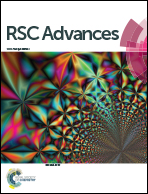Amorphous Ti(iv)-modified Bi2WO6 with enhanced photocatalytic performance†
Abstract
Crystalline TiO2 is a well-known oxide which can be used to improve the photocatalytic performance of other photocatalytic materials by a semiconductor-coupling strategy. However, compared with crystalline TiO2, amorphous TiO2-modified semiconductors have seldom been reported. In this study, amorphous TiO2 (referred to as Ti(IV)) as a hole cocatalyst was used to modify the photocatalytic performance of a Bi2WO6 photocatalyst by a facile wet-chemical method, where metallic Pt as the electron cocatalyst was also coated on the Bi2WO6 surface to promote the interfacial electron transfer. It was found that the dual-cocatalyst modified Ti(IV)–Pt/Bi2WO6 photocatalyst exhibited an obviously higher photocatalytic performance than the blank Bi2WO6 and single-cocatalyst modified Pt/Bi2WO6 and Ti(IV)/Bi2WO6. Based on the present experimental results, we propose a synergistic effect of amorphous Ti(IV) and Pt to illustrate the enhanced photocatalytic activity of the Ti(IV)–Pt/Bi2WO6 photocatalyst, namely amorphous Ti(IV) works as a hole cocatalyst to rapidly transfer the photogenerated holes in the valence band of Bi2WO6, while Pt acts as an electron cocatalyst to rapidly transfer the photogenerated electrons on its conduction band. As a consequence, the transfer rate and the interfacial catalytic reaction of photogenerated electrons and holes were simultaneously accelerated, which resulted in improved photocatalytic performance of the Ti(IV)–Pt/Bi2WO6 photocatalyst. The above synergistic effect mechanism in Ti(IV)-modified Bi2WO6 photocatalysts can further be demonstrated by using a low-cost Fe(III) or Cu(II) electron cocatalyst. The present study suggests that amorphous Ti(IV) can act as a new and effective hole cocatalyst for the enhanced photocatalytic performance of photocatalysts, which provides an approach for the design and development of high-performance visible-light photocatalysts with amorphous oxides.



 Please wait while we load your content...
Please wait while we load your content...